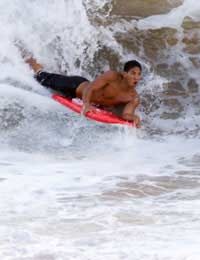Bodyboarding For Beginners

For those that think that surfing the wave is no longer exciting enough anymore then bodyboarding provides a loaded cannon full of head-dizzying new tricks and excitement on the water.
What is Bodyboarding?
Bodyboarding is wave surfing on a small semi rectangular and hydrodynamic board - once misleadingly known as a ‘boogie board’. It differs from traditional surfing in using a board that is much smaller and made from foam, and that is typically ridden lying down (‘prone’).It can also be ridden in a position known as the ‘drop knee’, where the surfer is half-standing with one knee touching the board. The large majority of bodyboarders wear swim-fins on both feet to aid in controlling trajectory and speed whilst riding, paddling out and taking off.
Safe Beginnings
Beginners are wise to sign up for a short course before taking the plunge. Spending a few hours in the water with an instructor will give a good grounding in the basic skills and safety essentials and provide knowledge of the local rip currents and rides. Most surfing schools offer bodyboarding lessons.First timers to the water are advised to begin by playing around in the white water (the shallow area of the sea, where broken waves form foaming water). The white water waves will have enough power to provide good practise in catching the first wave.
Keep Fit and Safe
In an activity governed by the unruly elements of wind and water it is important to be able to maintain a certain level of control, and so riders should be confident swimmers with good levels of strength and fitness.Before entering the water boarders must perform warm up and stretch exercises if they want to prevent cramp whilst in the water and muscle aching the next morning.
Take Care Entering and Leaving the Water
Boarders should avoid entering the water in the presence of strong shore breaking waves, but instead should wait until the waves hitting the beach are small. Naturally they should also keep away from rocks and currents. Upon leaving the water, boarders should resist taking off their fins until safely on the shore.Bodyboard in Company
Not only is it more fun to body board in the company of others but it also safer, especially for beginners. If any riders find themselves in trouble then a friend will be around to lend a hand. If there are no friends that share a passion for the sport, then surfing on a beach overlooked by the keen eyes of a lifeguard will provide an adequate alternative.Heed Local Knowledge
The advice of experienced local surfers on the area’s sea conditions, potential dangers and hazardous spots is indispensable for novice riders and should be sought out before setting out.Don’t Be Over Ambitious
The sea is a fierce and unforgiving place and it is not worth taking risks by trying to ride in conditions and over waves beyond the experience of the bodyboarder.Prepare and Check Equipment
A leash is an essential feature of a bodyboard because it helps prevent rider and board being separated permanently. Therefore, before setting out, the leash should be checked to make sure it is attached to the board properly and also for signs of general wear and tear. The leash should always be coiled to prevent twists that could easily wrap around legs, neck or arms and prevent swimming.As with most board watersports it is essential that the board is waxed regularly to prevent slipping whilst in the water.


Re: Parasailing
Can i know where can i do parasailing near brighton area in uk. Can you also send me the prices for it. Thank you
Re: Top UK Windsurfing Spots
Hi I've got a windsurf but I've never done anything like this is it easy to do and wear would I be best to practice
Re: Parasailing
I am 50 in april really want to do this para sailing
Re: Swimming in Rivers and Lakes
Swansswimmer - Your Question:A fine article containing good advice. I wish to add that the wearing of a wetsuit is not necessary.…
Re: Swimming in Rivers and Lakes
A fine article containing good advice. I wish to add that the wearing of a wetsuit is not necessary. I wore one as did my new…
Re: Parasailing
Gert - Your Question:Would like to have some information on where and how to book a parasailing eventO
Re: Banana Boats and Other Holiday Activities
Who regulates banana boating and similar activities in the UK?